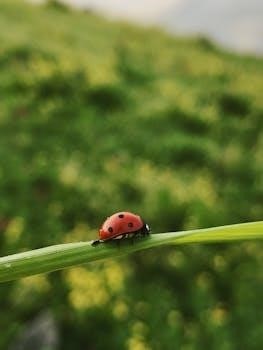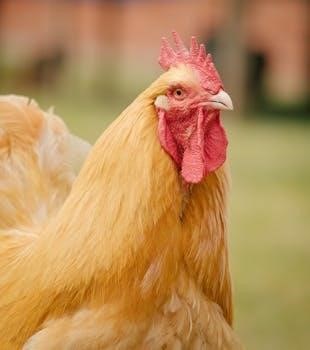
The Little Red Hen Story⁚ A Comprehensive Overview

The tale of the Little Red Hen, often found in PDF format, is a classic folk story. This narrative follows a hardworking hen through her journey of planting, harvesting, and baking bread. The story highlights self-reliance and the importance of diligence.

The story of the Little Red Hen, a timeless narrative often accessible in PDF format, begins by introducing a diligent hen and her lazy companions. This classic folktale, frequently included in children’s literature collections, typically features a barnyard setting with animals such as a dog, a cat, a pig, and sometimes a mouse or a duck. The hen is portrayed as hardworking, while the other animals are often depicted as idle and unwilling to assist with any tasks. The narrative usually starts with the hen discovering a grain of wheat, a pivotal moment that sets the stage for the rest of the story. This discovery sparks the hen’s desire to make bread, initiating a series of requests for help that are consistently denied by the other animals. The introduction establishes the core conflict of the story, contrasting the hen’s industrious nature with the laziness of her peers. This contrast forms the basis for the moral lesson that the tale aims to impart to its young readers, emphasizing the values of hard work, self-reliance, and the consequences of shirking responsibilities. The narrative is often told with simple, repetitive language patterns, making it accessible and engaging for young children.

The Hen’s Discovery⁚ Finding the Wheat
The Little Red Hen’s journey, often depicted in PDF versions of the story, commences with a significant discovery⁚ she stumbles upon a single grain of wheat, or sometimes a few grains. This seemingly small find serves as the catalyst for the entire narrative. The location of this discovery varies slightly across different retellings; some versions place it near the barn, while others might have the hen finding it in the garden. Regardless, the discovery is portrayed as a moment of opportunity for the diligent hen. Upon finding the wheat, her mind immediately turns to the possibility of making bread, showcasing her industrious nature and forward-thinking approach. This initial discovery sets the stage for the hen’s subsequent actions and highlights her proactive character. The grain of wheat is not just a random object; it symbolizes the beginning of a long and arduous process that the hen is willing to undertake. This pivotal moment underscores the contrast between the hen’s willingness to work and the other animals’ passivity. The finding of the wheat is a crucial plot point, driving the narrative forward and setting the premise for the hen’s repeated requests for assistance. It’s the spark that ignites her desire to create something useful from a simple seed.
Refusal of Help from Other Animals
Following her discovery of the wheat, as detailed in many PDF versions of the story, the Little Red Hen seeks assistance from the other farm animals. This is a recurring theme, where she repeatedly approaches her companions—often a dog, a cat, a pig, and sometimes a mouse or a duck—asking for their help at each stage of the process. However, her requests are consistently met with refusal. The animals provide various excuses, such as a desire to sleep, play, or simply a lack of interest. This consistent rejection highlights their laziness and unwillingness to contribute to any work. Their repeated “Not I” responses emphasize their passivity and lack of responsibility. This refusal of aid is not a one-time event, but rather a pattern that occurs throughout the story. The hen’s repeated attempts and the animals’ consistent refusals underscore the contrast between her industriousness and their idleness. It showcases the animals’ lack of understanding of the value of hard work and their unwillingness to participate in a communal effort. The animals’ refusal to help serves as a central conflict within the narrative, driving the plot and emphasizing the theme of self-reliance. This refusal not only advances the plot but also accentuates the hen’s determination and the moral message of the story.
Planting and Growing the Wheat
After the other animals refuse to assist, as depicted in numerous PDF versions of “The Little Red Hen,” she takes it upon herself to plant the grain of wheat. This marks the beginning of her solitary effort, a testament to her hardworking nature. The hen diligently prepares the soil, plants the seed, and nurtures it with care. She understands that for the wheat to grow, it requires her constant attention. She waters the newly planted seed, ensuring it receives adequate moisture. She also makes sure the soil is suitable for the wheat to thrive. She is the only one tending to the seed, protecting it from harm, and making sure that it grows healthy. Unlike the other animals, who spend their time relaxing, the hen is committed to her work. The process of planting and growing the wheat is a journey that she undertakes alone, emphasizing her self-reliance and her dedication. As the wheat grows, it symbolizes her hard work and perseverance. Her consistent effort serves as a sharp contrast to the inactivity of the other animals. This phase of the story highlights the initial stages of the hen’s determination and sets the stage for the subsequent steps. The growth of the wheat represents her commitment to hard work.
Harvesting the Wheat
Following the patient nurturing of the wheat, the time for harvesting arrives, a pivotal moment often illustrated in PDF versions of “The Little Red Hen.” The little red hen, having dedicated herself to the growth of the wheat, is now faced with the task of collecting the mature grain. She understands that the fruits of her labor are ready for the next stage of the process. Once again, she approaches the other animals, who are still enjoying their leisure, hoping they will finally help. She asks for their assistance in gathering the ripened wheat, but again they refuse. Undeterred by their lack of cooperation, the little red hen begins the strenuous task of harvesting the wheat on her own. She carefully cuts down the stalks of wheat, gathering them into bundles. The physical labor of harvesting is demanding, but she perseveres. The act of harvesting the wheat serves as a visual representation of her dedication and hard work, showcasing the tangible results of her efforts. This stage reinforces her self-reliance and contrasts her work ethic with the laziness of the other animals. The scene emphasizes the consequences of their inaction. The harvested wheat is a symbol of her commitment.
Milling the Wheat into Flour
After the laborious task of harvesting, the Little Red Hen is faced with the next step⁚ transforming the gathered wheat into flour, a process often depicted in detail within PDF versions of the story. This stage is crucial, as the grain cannot be directly used for baking. The hen, understanding the necessity of milling, once again seeks help from the other farm animals. She approaches them, requesting their assistance in grinding the wheat into flour. Predictably, the dog, the cat, and the pig decline her request, each finding reasons to avoid the hard work. Undaunted by their refusal, the Little Red Hen takes on the responsibility herself. She diligently works at the mill, grinding the hard kernels of wheat into a fine powder. The process of milling is both time-consuming and physically demanding. The turning of the millstone requires significant effort and persistence. This stage highlights the hen’s commitment to completing the process from start to finish. The act of milling symbolizes the transformation of raw materials into a usable form. It underscores the level of effort required to produce even basic food items. The flour, now ready, is a testament to her dedication.
Baking the Bread
With the flour now finely milled, the Little Red Hen proceeds to the next stage⁚ baking the bread, a process often illustrated in PDF versions of the tale. This step requires the hen to combine the flour with other ingredients, such as water and perhaps a bit of salt, depending on the version of the story. The hen, once again, approaches her fellow farm animals, seeking their help in this final phase. She asks if they would be willing to assist her in mixing the dough and tending to the oven. Just as before, the dog, the cat, and the pig refuse her request. They offer various excuses for not helping, showing a continued lack of willingness to participate in any part of the process. The Little Red Hen, not surprised by their lack of cooperation, sets out to bake the bread herself. She carefully mixes the ingredients and kneads the dough, a task requiring both strength and skill. She then places the dough into a preheated oven, monitoring it closely as it bakes. The aroma of the baking bread begins to fill the air, tempting those who did not assist in its creation. This stage is a culmination of all her efforts. The transformation from grain to bread is complete.
The Hen Eats the Bread Alone
The culmination of the Little Red Hen’s tireless efforts arrives when the freshly baked bread emerges from the oven, golden brown and fragrant. Now, the other farm animals, who had previously refused to help at each stage, suddenly become interested in the fruits of her labor. The dog, the cat, and the pig approach the Little Red Hen, likely expecting a share of the delicious bread. They had watched her work from afar, not lifting a paw to assist. They now gather around, perhaps with hopeful expressions, anticipating a taste of the freshly baked loaf. However, the Little Red Hen, remembering their repeated refusals to help in planting, harvesting, milling, and baking, decides to eat the bread all by herself. She reminds them of each step where they declined to contribute, highlighting their laziness and lack of cooperation. She then proceeds to enjoy the bread alone, a well-deserved reward for her hard work and dedication, and the PDF versions often depict this moment. The other animals are left to witness her enjoying the meal, a silent lesson in the consequences of their inaction.
Moral of the Story⁚ Hard Work and Self-Reliance
The enduring message of the Little Red Hen, often emphasized in PDF versions of the story, centers on the values of hard work and self-reliance. The narrative underscores that consistent effort and dedication are crucial for achieving goals. The Little Red Hen’s journey, from finding a single grain of wheat to baking a loaf of bread, exemplifies the importance of taking responsibility and not relying on others to do your work. She faced numerous tasks, each requiring time and effort, and completed them all herself when others refused to help. This highlights that even when faced with challenges, one can still succeed through their own determination. The story effectively illustrates that those who are unwilling to contribute will not reap the rewards. The other animals’ refusal to assist the hen results in them being excluded from enjoying the bread. It teaches children that laziness and lack of cooperation have consequences. The Little Red Hen’s example serves as a powerful lesson in the value of self-sufficiency and the satisfaction that comes from one’s own accomplishments, often a key takeaway highlighted in educational materials, including PDF versions of the story.
Variations and Adaptations of the Story
The Little Red Hen story, often available in various PDF formats, has seen numerous variations and adaptations over time. While the core narrative remains consistent, different versions might feature diverse farm animals or slightly altered dialogues. Some adaptations modernize the story, placing it in a contemporary setting, or introduce new characters. These changes often aim to make the tale more relatable to current audiences, while still retaining its central theme of diligence. Certain retellings focus on specific aspects of the story, like the step-by-step process of baking bread, providing a detailed look at the hen’s efforts. Adaptations may also vary in their intended audience, with some versions geared towards younger children using simpler language and illustrations, while others are designed for older kids with more complex vocabulary and themes. Some versions may emphasize different moral aspects, such as the importance of teamwork versus self-reliance. There are also multicultural retellings, which may incorporate different cultural elements, showcasing how the story’s core message resonates across diverse communities. These variations and adaptations, often found in accessible PDF formats, ensure that the Little Red Hen’s timeless lesson continues to reach and engage new generations.
Educational Uses and Resources (PDFs and More)
The Little Red Hen story, commonly available in PDF format, is a valuable resource for educators. Its simple narrative and clear moral make it ideal for teaching young children about hard work and responsibility. Teachers often utilize PDF versions of the story for classroom reading sessions, encouraging children to follow along and discuss the hen’s actions. Beyond the basic story, educators use the tale to explore themes of self-reliance and the consequences of laziness. Many free PDF resources offer supplementary activities, such as coloring pages, sequencing exercises, and matching games, enhancing children’s engagement with the story. Teachers may use the story to introduce vocabulary related to farming, food preparation, and cooperation. The easily accessible PDF format of the Little Red Hen story allows for easy distribution and use in various educational settings. Online resources, often including printable PDFs, also provide lesson plans, craft ideas, and interactive games centered on the story. These resources can cater to different learning styles and developmental stages. Furthermore, variations of the story in PDF form are used to explore different cultural perspectives and storytelling techniques. Educators also use the story to prompt discussions about the value of contributing to a community and the importance of helping others. The availability of the story and related materials in PDF format makes it a very useful tool for educators.

No Responses